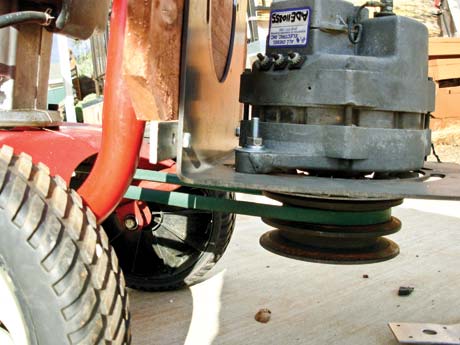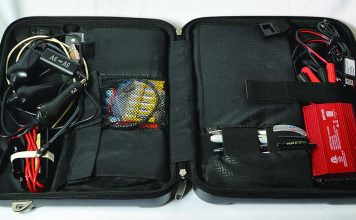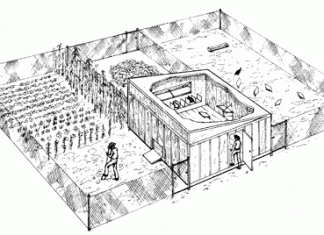| Issue #131 • September/October, 2011 |
Ever wonder how you could live off the grid when the sun isn’t shining on your solar panels?
Our homestead alternative energy system is based on 12 volts direct current. That is what your car battery supplies. Many smaller store-bought generators supply only 115 VAC alternating electricity. They are great for powering up your power tools or standard home appliances but are pretty inefficient for charging 12-volt batteries.
If you are into 12 VDC (volts direct current) for charging your car battery or powering up your off-the-grid alternative energy system you need a 12-volt DC generator.
As a homesteader having no special training, licenses, or badges, I wanted an inexpensive solution for electricity that does not require any special skills or tools.
We all know our cars and trucks contain a 12-volt alternator or generator that is powered by the engine. It keeps the lights, radio, and heater fan supplied with electricity.
|
I wanted to generate some electricity and not spend a lot of money. My goal was to charge a dead car battery, play my radio, light up some indoor and outdoor lights, run my computer, charge up some flashlight batteries, and run some other low power gadgets.
A fun destination for us these days is a trip to the local hardware store. We walk the aisles and get ideas for new projects we hope to do someday. On a recent trip I spotted something unusual. In a row of $200-300 pressure washers, I saw a unit sporting a large handwritten $25 price tag. The manager said the new washer had been returned and did not work, and the estimated cost of the repairs would be more than the unit had sold for originally, so they were just trying to get rid of it. It had a new Honda gas engine and that alone had to be worth more than $25. The water pump had failed, but I didn’t need a power washer. I had another project in mind.
On the way home, I stopped by the local auto dismantler yard. I was looking for the largest, cheapest, cleanest truck alternator I could find on the part shelves. The owner quickly understood what I was trying to do, handed me a large truck alternator, and rang me up for $20. Back at my workbench, I dug around and found some scrap heavy-gauge sheet metal pieces to make some mounting brackets. By cutting and pasting I was able to match where I would mount the alternator so its drive pulley would be lined up with the drive pulley on the vertical shaft gas engine. I used my electric drill to drill some holes in the metal brackets to match up the mounting holes on the alternator. The sturdy brackets were attached to the metal engine frame and the used alternator with ¼-inch machine screws, lock washers, and nuts.
A challenge for me was fitting the pulleys to the correct size rubber belt. The belts come in many shapes and sizes and it took me three tries to get the right one. The size and depth of the pulley grooves is important to prevent early belt wear from slippage.
|
I was going to rig a strong spring for a belt tensioner. For now I just used some shims behind the mounting bracket to tighten up the belt.
Now for the big test run. The nearly new gas engine fired up with the first pull on the starter cord. Despite the load resistance from the pulley belt and the alternator, the engine turned the alternator at a good steady RPM.
Voltage meter in hand, I checked the voltage output and it was zero. No power. Shock and panic! Naturally my first thought was that my bargain alternator wasn’t working, but then I remembered that an alternator must be connected to a 12-volt battery to establish a “field current.” When I connected the alternator terminals to my storage battery with jumper cables, all was well. The battery charged to full capacity after a few minutes.
Now it was clear that I had a new electric power-producing capability. On a dark, cold, rainy day when my solar panels or wind generator are not producing charging current, I now have another option for self-reliance. Any lawn mower engine from a garage sale could be used with any used car alternator for this project.

















I am thinking I want to do this but water power. What vslue of PRM will I need? Is is listed on alternator? thanks